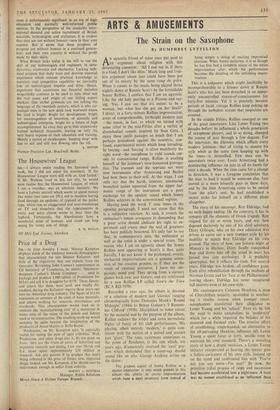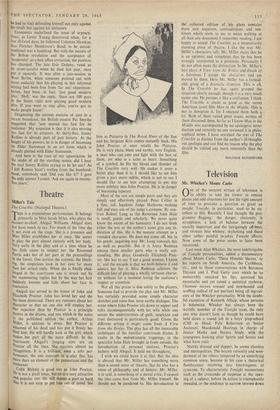ARTS & AMUSEMENTS
The Strain on the SaxophOne
By HUMPHREY LYTTELTON
A N agnostic friend of mine once put paid to anat.' argument about religion with this devastating comment: 'All I can say is, if there is a God, I don't like Him.' Much long and fruit- less argument about jazz could have been put out of its misery by the same coup de grace. When it comes to the music being played thrice nightly down at Ronnie Scott's by the formidable Sonny Rollins, 1 confess that I am an agnostic. Like the old lady peering at a Picasso and say- ing, 'Yes, I can see that it's meant to be a woman, but what has she got on. her head?' I detect, in a forty-minute Rollins improvisation, areas of comprehensible, forthright modern jazz —the music, in fact, to which we turned with some relief in the mid-Fifties after a surfeit of disembodied sounds inspired by Stan Getz. I enjoy these sunlit passages so much that I am perhaps prejudiced against the eccentric, con- fused, experimintal noises which keep intruding. In forcing—and 'forcing' is often manifestly the right word—the saxophone to yield sounds out- side its conventional range, Rollins is availing himself of the jazzman's time-honoured preroga- tive. The trumpet and the soprano sax were new instruments after Armstrong and Bechet had bent them to their will. At this stage, I can only say that the harsh, insecure, attenuated, bronchial noises squeezed from the upper •har- monic range of the instrument are a poor exchange for the opulent sound which Sonny Rollins achieves in the conventional register.
Having used the word 'I' nine times in the opening paragraph, I need not stress that this is a subjective reaction. As such, it reveals the enthusiast's innate arrogance in demanding that a great artist should abdicate his right to ex- periment and create once the seal of greatness has been publicly bestowed. It's only fair to say that, in contemporary jazz, the enthusiast as well as the artist is under a special strain. The reason why I am an agnostic about the Sonny Rollins now appearing at Scott's is that, quite literally, I do not know if the prolonged, erratic, uncharted improvisations are a genuine exten- sion of the creative process, or if they are the result of external pressures. I have my sus- picions, mind you. They spring from a cursory glan6c back over jazz history, and are reinforced by a new Rollins LP called Now's the Time (RCA RD-7670).
Recorded a year ago, the album is devoted to a selection of modern jazz 'classics' ranging chronologically from Thelonius Monk's 'Round Midnight' (1944) to Benny Golson's 'I Remem- ber Clifford' (1956). Disciplined to some extent by the material and by the purpose of the album, Rollins eschews the wilder and more surrealistic flights of fancy of his club performances. His playing, albeit entirely 'modern,' is quite con- sistent with the notion of a poised and mature jazz 'giant.' The tone, cavernous sometimes to the point of flatulence, is the one which, ten years ago, dramatically reversed the 'cool' pro- cess which demanded that a tenor-salt should sound like an alto. George Avakian writes on the sleeve:
The greatest aspect of Sonny Rollins as a master improviser is very much present in this album the ability to create improvisations which have a total structural form instead of being simply a string of exciting improvised choruses. When Sonny performs, it is as though he has first had a complete vision of the entire improvisation after which the performance becomes the detailing of the unfolding impro- visation.
This is a judgment which might justifiably be incomprehensible to a listener down at Ronnie
Scott's who has just been drenched in an appar- ently uncontrolled stream-of-consciousness for forty-five minutes. Yet it is precisely because periods of lucid, vintage Rollins keep poking up through the turbulent stream that suspicions are aroused.
In the middle Fifties, Rollins emerged as one of the great innovators. Like Lester Young two decades before, he influenced a whole generation of saxophone players, and in so doing, changed the course of jazz through a few degrees. For the innovator, the dilemma which afflicts every modern jazzman—that of trying to mature his style while at the same time keeping up with the times—is intensified. Few men can be innovators twice over. Louis Armstrong had a dominating influence on jazz in all its facets for over a decade. When the time came for' a change in direction, it was a foregone conclusion that the man to lead it would be someone else. Jazz
moved at a more leisurely pace in those days, and by the time Armstrong came to be ousted from the pilot's seat, he had established a secure niche for himself on a different plane altogether.
The story of his successor, Roy Eldridge, had no such happy ending. On the contrary, it has in synopsis all the elements of Greek tragedy. Roy reigned for six or seven years, and was then deposed decisively by one of his chief admirers, Dizzy Gillespie, who on his own admission was driven to carve out a new trumpet style by his inability to match Roy Eldridge on his own ground. The story of how, one historic night at
Minton's in Harlem, Dizzy finally vanquished Roy and drove him off the stand in tears has
Passed into jazz mythology. It is probably
apocryphal, but it reflects the truth. For several years, Eldridge was broken, all confidence gone.
Even after rehabilitation through the medium of Norman Granz and his 'Jazz at the Philharmonic' touring shows, Eldridge has never recaptured full mastery even of his own style.
His contemporary Coleman Hawkins, a man of Churchillian tenacity, succeeded in weather- ing a similar reverse when younger tenor- saxophonists transferred their allegiance to Lester Young and his 'school.' Even so, he felt the need to make concessions to 'modernity' which for a while impaired the balance of his matured and finished style. The creative effort of establishing, single-handed, an alternative to the all-pervading Hawkins influence left Lester Young a spent force at forty, unable even to maintain his own standard. There's a revealing story of how a drunk musician, a Lester Young imitator exasperated at hearing the master give a listless caricature of his own style, jumped up on the stand and confronted him with 'You're not you any more—I'm you!' By now, the primitive tribal process of reign and succession had become accelerated into a nightmare. A man was no sooner established as an 'influence' than
he had to start defending himself not only against his rivals but against his imitators.
Economics underlined the sense of urgency.
Once, as Lester Young discovered when, for a kw ill-fated days, he followed Coleman Hawkins into Fletcher Henderson's Band, to be uncon- ventional was a handicap. But with the success of the Bebop revolution and the acceptance of 'modernity' as a box office attraction, the position has changed. The late Eric Dolphy, rated as an avant-gardist when he died last year, once put it squarely. It was after a jam-session in West Berlin, when someone pointed out with some audacity that his playing in this informal setting had been free from 'far out' experimen- tation, had been, in fact, 'just good modern alto.' Hell,' was the reply, 'there are 500 guys in the States right now playing good modern alto. If you want to stay alive, you've got to make people listen!'
Diagnosing the current malaise of jazz in a
recent broadcast, the British pianist Pat Smythe suggested that 'jazz moved too fast for its audience.' My suspicion is that it is also moving too fast for its creators. At thirty-five, Sonny Rollins is already part of jazz history. At the height of his powers, he is in danger of becoming an Elder Statesman in an art form which is already glutted with Elder Statesmen.
And here is the root of my agnosticism. In the midst of all the startling noises, did I hear the real Sonny Rollins crying to be let out? As I left Ronnie Scott's reeling from the bombard- scimebody said 'Did you like it?' I gave the only answer I could. 'Ask me again in twenty- live years.'



































 Previous page
Previous page